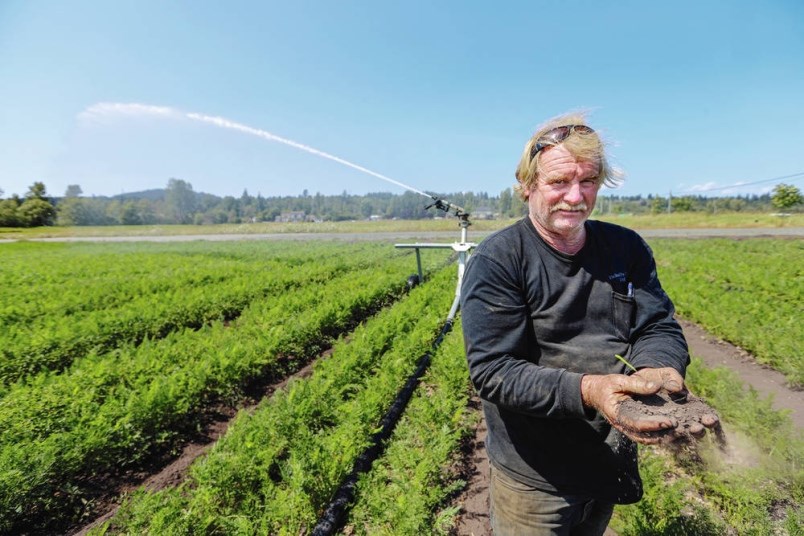At Michell Farms on the Saanich Peninsula, the pumps are working 24/7.
Water is rushing out of wells at about 600 gallons a minute into a series of ponds, and then pushed through pipes to irrigation systems to keep the family’s crops alive and growing.
With no measurable rain for nearly two months now, and nothing but heat in the forecast, water is becoming a precious resource.
On many of the Gulf Islands, visitors are being asked to bring their own water. Residents are urged to do everything to preserve wells, aquifers and natural bodies of water. Some marinas aren’t filling water tanks for boaters.
“We need to do everything, everything we can to preserve our water,” said Peter Luckham, chair of the Islands Trust council. “We’re already in [late] July … and we could go the whole summer and even into October without any rain.”
The province has already declared the eastern side of Vancouver Island and the southern Gulf Islands at Level 4 on its drought warning system, where the lack of rain is starting to hurt fish stocks and ecosystems, and water shortages in private wells are being reported.
Drought Level 5 is rated as the most severe, where adverse impacts to socioeconomic or ecosystem values are deemed “almost certain.”
Luckham said unlike those in cities, most residents and businesses on the Gulf Islands rely on well water or catchment tanks for everyday use. He’s heard of waterlines on the ground at some residences “simply exploding” in the heat wave. Residents are rushing to fix leaks or drips to save every drop.
Luckham said dry wells have the potential to affect entire communities. “The health and integrity of wells and the aquifers not only sustains people and businesses, but also the natural ecosystems.”
He’s noticed oceanspray, also known as creambush, which grows on coastal bluffs on the Gulf Islands, that is dead or dying.
Bryce Rashleigh, who has about 1,000 acres in wheat, barley and hay crops on the south Island, said the drought will bring an earlier harvest with smaller grain kernels and reduced yields.
Rashleigh’s wheat is used in Island bakeries and the entire barley crop goes to Phillips Brewing.
“It’s day 41 without any rain … it’s dry out here and it’s definitely had an effect,” Rashleigh said.
The ongoing dry spell is drastically cutting beef and dairy herds on the Island and across Canada, Rashleigh said, which has led to a major problem for his hay operation.
Rashleigh produces hay on about 700 acres. He cuts it in late spring, bails and wraps it with a 40% moisture content for cattle and horse feed.
The problem is that herds are being reduced. There is now only one dairy herd south of the Malahat and 34 on the Island. In the 1980s, there were 16 on the Saanich Peninsula alone.
The pandemic also wiped out demand from his major customer — tourism’s horse-carriage industry.
So he’s sitting on about 5,000 big round bales without any buyers.
Rashleigh contacted Agriculture Minister Lana Popham last week, saying he needed help getting feed to producers elsewhere in the province who need it. She visited the farm and listened to his concerns about food security on the Island.
He said the Island still heavily relies on importing much of its food from the U.S. and the Lower Mainland, and has a three- to five-day supply in the event of a catastrophic event that impedes transportation.
Popham declined an interview request, but said in a statement the province is working with producers. “The ministry has a dedicated team of staff working closely with our sector during emergencies like drought and wildfires.
“Ministry specialists are continuing to monitor the impacts of the losses, and depending on the extent of damages, we are looking at what forms of support may be needed beyond our existing program supports,” the statement said.
According to the Agriculture Ministry, growers have filed 811 production-insurance claims related to extreme heat. Of those, 122 are from Lower Mainland berry farmers and 689 are from tree-fruit growers in the Okanagan Valley.
While losses for extreme heat are unusual and significantly higher than in previous years, the total number of claims is similar to previous years, it said.
The Capital Regional District said the Sooke and Goldstream reservoirs are at 79.5% capacity, which is normal for this time of year, according to a spokeswoman. Stage 1 water restrictions remain in effect.
However, water use is increasing. For the week ending July 25, 224.3 million litres per day was being used, up from the five-year daily demand of 197.3 million litres per day from 2016 to 2020.
Michell said he is no longer irrigating hay fields. He’s cut enough to feed the family’s own beef herd, and is focusing all the water — including connections to CRD water supplies — on vegetables and orchards.
The Michell family has been farming on the Saanich Peninsula since 1862 through six generations, and weathered droughts before. Michell says historically, it has almost always rained on Labour Day to push the crops through.
“There’s no question we’re in a drying trend,” he said. “Without irrigation we’d be finished.”




